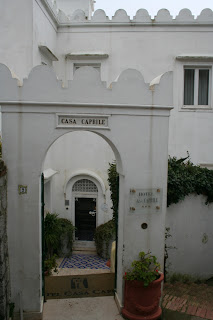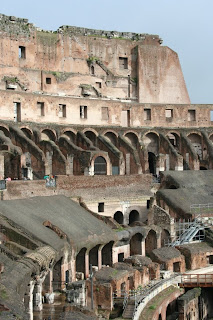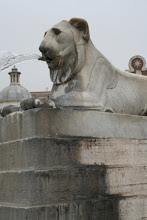

Early start today – I’m booked on a Context tour to cook some Roman and southern-italian food with docent Daniela del Balzo.
Our day starts at the Café Barberini on Via Mamorata in the Testaccio district and we meet up with Daniela outside. We’re a mixed bunch – a couple from Michigan, another couple from Boston, plus me adding Australia to the mix. Both american couples are here for a single week only and they’ve been sightseeing hard, with little time to sit in piazzas and while away an hour or two.
Our first stop is a pasta ‘Laboratory’ where all the pastas are made fresh daily. The front-of-house has the most wonderful looking filled pastas and crepes on display, including an artichoke and ricotta filled caramelle – so called for the sweet-shaped style of the pasta. We meet the owner and he takes us out into the factory area. A huge machine is combining a long sheet of pasta and some meat filling into tortellini. We take turns to climb up on to the machine and watch this transformation. A woman is filling crepes by hand and arranging them on a platter. The colour of both the pasta and the crepes is a strong yellow and Daniela explains this is solely due to the colour of the egg yolks.
Next we head off to the Testaccio market. After the Campo dei Fiori, this market seems less picturesque and more workaday, but the produce is far more varied – beautiful breads, fruit and vegetables, meats, cheeses, pots and pans; there is even a stall for pets. I think about buying a natty checked collar for Jasper but decide against it.
Daniela buys some artichokes for the pasta we’ll be making later; the stall owner selects and trims them, adds some lemon to prevent discolouring, and bags up the artichokes in record time. We buy thinly sliced veal for saltimbocca, plus pancetta and guanciale – similar to pancetta, but from the cheek of the pig. We also buy long, thin eggplants for a stuffed eggplant dish. I’ve never seen eggplants like these; we have to make do with the large and bulbous specimens at home. I vow to buy some Italian seeds and try to grow this variety.
We’ve now got all we need and we head up the hill to Daniela’s apartment on the Aventine Hill. Its a lovely, light filled and contemporary space with a state-of-the art kitchen. We all don aprons and sit around a long workbench to talk food and drink espresso. Daniela is concerned we might be hungry, so we sit with huge hunks of foccacia while we discuss today’s menu. We’ll start with an appetiser of bruschetta, served with tomatoes seasoned with marjoram, and then move on to pasta with artichokes and pancetta, then veal 2 ways – saltimbocca (sage and prosciutto) and invotini (stuffed with vegetables). For desert, Daniela has already made a tiramisu, explaining that the desert needs several hours to settle and therefore must be made ahead of time.
I’m interested in how artichokes are prepared for a pasta sauce, having never cooked them this way. It’s quite simple: the artichoke is halved and the choke removed, and its then sliced thinly and put into acidulated water to stop discoloration.
While we’re cooking, the family cat meanders in. He’s the largest cat I’ve ever seen, and this is explained by the hoard of scraps that are set aside for him. He obviously eats quite well in this household, and a varied diet he has, too, judging by today’s menu.
After some chopping of eggplants and rolling of saltimbocca, and lots of conversation and shared stories about Rome, we sit down to eat. We’re drinking Casale del Grigio wine from the Agro Pontino valley 30 kms south of Rome. We start with a Satrico, which is a blend of Chardonnay, Sauvignon Blanc and Trebbiolo. Like all Italian wines, it tastes more of the fruit and less of the oak. This white is fantastic with our pasta, and we move on to a Merlot and then a Shiraz with the veal and eggplant dishes. I’m eating more than I’ve eaten all week, and there’s still desert. With the tiramisu, we have Daniela’s home-made limoncello – delicious but powerful.
At 3pm, we all stagger into our coats and gather up our food notes and recipes from today. It’s been great to spend a day in Daniela’s kitchen and to visit the Aventine district - a new part of Rome for me. Daniela is keen to talk more about our planned trip south (she is from Naples) and asks me to ring her before Jim and I set off to Puglia and Basilicata. I promise to do this, and head back along the Tiber, past Tiber Island to the apartment. I’m definitely inspired to try some more cooking in my last week – and I’ll be coming back to the Testaccio markets again before we leave Rome.
 Since I've been back and shared stories of Rome with friends and family I've also promised a link to Rome-is-Home, the wonderful apartment I rented for all of February. So here it is.
Since I've been back and shared stories of Rome with friends and family I've also promised a link to Rome-is-Home, the wonderful apartment I rented for all of February. So here it is.

























 Rome is experiencing sunny blue skies at the moment – this is our third day of clear weather. These photos were taken yesterday from the top of the Capitoline Hill; in the first, and looking towards the west, you can see the dome of the church of San Andrea delle Valle (one of my near neighbours) and further on, the dome of St Peter’s.
Rome is experiencing sunny blue skies at the moment – this is our third day of clear weather. These photos were taken yesterday from the top of the Capitoline Hill; in the first, and looking towards the west, you can see the dome of the church of San Andrea delle Valle (one of my near neighbours) and further on, the dome of St Peter’s. 
















